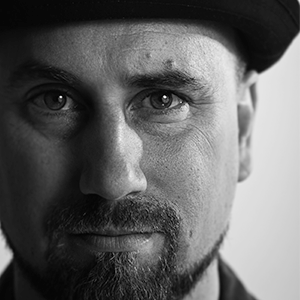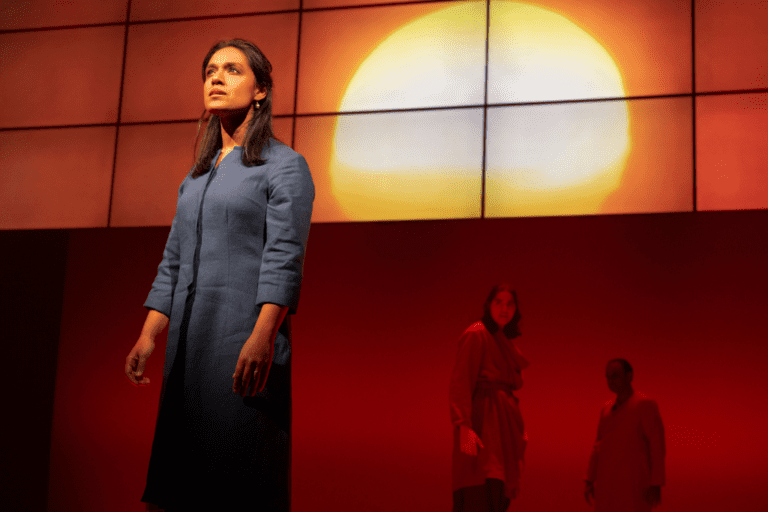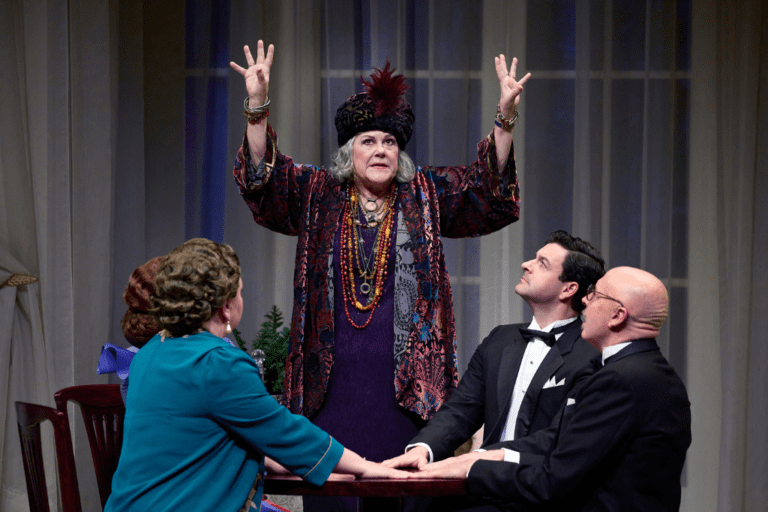A (sort of) Manifesto: Running Between Theatre and Film, Reimagining the Live Experience
Most artists can take a tiny budget and produce magic. We’re constantly creating new worlds, images and stories with nothing but shoestrings and determination. That is both our superpower and our curse. When done well, most audience members will never know the difference between a show by a large theatre house and one from an emerging collective. It’s very much a part of the joy of creation: finding interesting solutions and discoveries, stretching our health, bodies and imaginations, at times to the breaking point, in order to see our visions come to life. We can compress months of work into weeks, creating performances that defy our lack of resources. This pressure offers two outcomes; it can help us create diamonds or it can crush us. And now, with the world upside down, amidst the frustration of theatre closures, perpetual lack of focus and ever-present feelings of dread around every corner, it may feel like we’re being crushed. But we, as theatre artists, have another opportunity to do what we’re oh so very good at; adapting, reimagining and creating a new form of storytelling.
I’m sure all of us, artists and civilians alike, have screamed “What’s the point?!” into the abyss at some point in the last ten months. We’ve all either taken part in or watched a wide variety of online offerings from theatre artists, whether they’re fully filmed professional productions or the always questionable, physically distanced, new-world order Zoom readings featuring internet lag, frozen feeds, or mismatched props that are magically passed between screens. But as a community, we may have missed the part where we realize this new upside-down world offers us some interesting opportunities. The gatekeeper’s gates are crumbling. We are free of the stages and spaces we can’t afford and those venues that, until this year, we believed would give our work legitimacy. Big theatre houses still have an advantage in this new reality; they have money and space. Independent artists have a much larger challenge, but don’t we always? We’re used to this kind of adversity and we can use these opportunities to create truly innovative and exciting new work.
The development of new, temporary (though laudable) granting sources—like those from the Calgary Arts Development Authority and the Rozsa Foundation, to name two here in Calgary—have been offered to allow artists to explore new areas of creation, specifically in the digital realm. But money will only take you so far. Even the big, fancy theatre companies have produced extremely boring and, if we’re being honest, at times awful productions (I know you’ve thought it, so there, I said it for you, you’re welcome), often with budgets that independent artists would kill for. But now we’re all creating work on the same platform. This is the time to focus on breaking new creative ground, maybe with a dash of revolution. Wishing for the return of traditional theatre is wasted energy given the current circumstances. We have an opportunity to create a new form of performance, somewhere between theatre and film, that can and should exist beyond this pandemic. A hybrid that can borrow cinematic devices while retaining the energy and ‘liveness’ that makes theatre so thrilling.
From July to September 2020, I collaborated with Network Technician Wil Knoll of unit2studios and Photographer Tim Nguyen of TimNguyenCo. I must pause here for a moment. To simply title my co-creators as ‘technician’ and ‘photographer’ is a mistake; this is where many streamed performances have faltered. When assembling a team, you’re not simply finding people to plug things in and flick switches or film something you’ve designed in a standard, staged-theatre form. Both of my partners in this project, along with the actors, Val Duncan, Donna Ng and Trevor Loman, are thoughtful, exceptionally creative artists in their own right, who also happen to be very knowledgeable about the dramaturgy of theatre. They understand the form, so they can transform it in truly meaningful ways. We devised and co-directed an investigation of how a theatrical play can be reimagined within a digital world, asking different questions of ourselves as artists, examining our disciplines, and offering possible solutions in a finished, live-streamed (as in, performed live every night), four-show run of my one-act play, Like Tom Cruise Loves Running.

The creation of many of the digital offerings during this pandemic has felt very one-sided. When everything first shut down, focus was difficult at best, burnout was a little too real, and stress was riding high. But we’re now ten months into this mess and it seems like artists are not yet considering the audience’s engagement; some are simply streaming their content, hoping no one will notice the difference. So, as a collective, we asked ourselves at the very beginning of our process: how can we create ‘live theatre’ that will be viewed on screens of varying sizes? Everything needed to be developed with an understanding of how the final production would be viewed by the audience. When you want to present that content on a device that is used to watch films, TV shows, high-quality YouTube content, TikTok videos and cute freakin’ kittens, certain factors need to be addressed. The stage and the screen are two extremely different platforms and if concessions are not made, the work will not translate as you feel it should. The quality of the offering needs to be, at the very minimum, presented with an awareness of this divide.
The following seven tenets are based directly on the discoveries we made during our experience bringing Like Tom Cruise Loves Running to life, and, in my personal opinion, are the main elements to be considered when creating online theatre. Yes, some of these might seem obvious, but sometimes the most obvious elements are the things we too often overlook—emerging and professional artists alike. As with any production, we made some mistakes; there were early tech issues, mistimed audio, odd concepts and camera movements that had to be altered and reimagined according to our space and budget. That’s not to mention the lack of time and money to fully explore all of our ideas, and several other issues. Most productions, no matter the size, will end with a list of ‘things to do better next time’, and ours was no different. You may judge for yourself whether we succeeded or not (https://youtu.be/-9-TXvStoBE).
And now, the (sort of) manifesto:
1 – Choice of Material (Pace and Timing)
As a playwright, I’ve never really had a reverence towards the ‘classics’, so I’m now even more cynical towards anyone who would subject an audience to a three-hour Zoom production of Shakespeare in these times. And come on—Waiting for Godot, is boring at the best of times and gets more attention for its adorable casting than the actual play. That’s right, I said it for you again. Now is the time for new work and new, or at the very least, living, writers. Now is the time for risks!! Remember that freaky little script you love that keeps getting rejected? Now is its time! Take it out of the drawer and let it live! You don’t need anyone’s permission anymore.
We chose my one-act play Like Tom Cruise Loves Running for several reasons. First of all, it is written in a poor-theatre, meta-theatrical style, which allowed for an ease of adaptability into whatever container we needed. Second, it is only 35 minutes long. With many of us working from home and staring at screens all day, it’s a BIG ask to invite people to even more screen time. A short run-time will make it easier for that reluctant audience member to commit. The short length allowed casual audience members to take a chance and join in without losing an entire evening. Keeping the time relatively short also encouraged some audience members to tune in and watch multiple times, maybe to see what they might have missed or how it developed over different nights, or maybe because they enjoyed it and simply wanted to see it again.
Finally, Like Tom Cruise Loves Running has a very quick pace, which allowed us to keep the energy high. The pace of the piece was important because the audience watching these productions can, in a millisecond, switch back to their streaming service provider of choice. And there’s a 99% chance that no matter what they land on, it will have better production value then what you are offering—those streaming services have more money for production than theatre practitioners could even imagine, and we can imagine pretty much anything.
Keep it under an hour and make it count—anything more than an hour and you better be brilliant.

2 – Tech = Freedom
This isn’t plug-and-play. The technical requirements and possibilities need to be a part of your concept from the very beginning. It goes without saying that a good director should listen to their collaborators, but in this new structure, it is imperative. Humble up and allow the voices that understand the different elements of media to be heard. Bring them in on day one! They are part of the team and may have questions and solutions you would never have considered. Is it going to be pre-recorded or live? How will the audience access the content and on what platform? Are you using mics or live sound? What will you need to stream in HD? How do you reduce the motion blur caused by streaming? When was the last time you talked about bitrates in a production meeting? At the beginning of our process, I, not being a tech person, had no idea to even ask these questions.
Wil had the idea of using face mics, which allowed us to balance and mix the dialogue evenly and cut down on room sound without worrying about where the camera was pointed. This freed Tim to work toward his strengths and focus on strong images and framings. Creating a foundational opening image allowed the audience to orient themselves so they knew who was talking and when, even if the camera was not focused on the speaker.
Finally, making the process as user friendly as possible is key. Don’t send your audience on a wild goose-chase of clicks and web pages and sign-ins. Create a link, embed it into a website you already have, or create a new one, and make sure the feed is obvious and visibly available with the least amount of effort.
3 – Filming/Direction
FYI: this is not film. I will repeat that; this is NOT film. The conversations I’ve had usually end with the question; if we, as theatre creators, just start filming plays, aren’t we just creating films? No. Because film is very much a matter of telling stories through moving images, and theatre’s life force is very much about live bodies performing in the moment. Although what we are producing is, again, NOT film, we can use (steal) many cinematographic staples: sweeping camera movements, POV shots, close-ups, multi-camera editing, push and pull focusing and so on.
In this new medium, the camera (or cameras if you’re so lucky) can move! Which means we can literally (hopefully emotionally as well) move an audience wherever we want them. The work is in being confident and clear about what you want to focus on, because the medium (tv and film) we’re accustomed to does this for us, and we’ve grown used to it. The camera decides the focus. Because of this, the metaphorical (and literal) lens needs to be thoroughly explored and practiced. How can you, as a storyteller, use this element to shift focus or tone to reflect your intentions? Like any other theatrical element or choice, the camera movements need to be intricately attached to the material—the camera, just like the actors, needs a reason to move. It also helps if you have someone on board who understands lighting through the camera as well as for the stage as these are entirely different.
We dedicated multiple sessions to allowing Tim to explore the space with a gimbal in real-time as we rehearsed, discovering ‘looks’ or possible framings. This kept things evolving, as Tim could ask the actors to repeat a few lines or replay a scene if he saw something he liked, and I could highlight moments and lines of dialogue that I felt needed to be captured ‘in-camera’. At the same time, Wil would be watching Tim’s feed on a monitor, noting strong camera movements and framings because ultimately, those elements determine how the performance will be viewed. Imagine a single director trying to juggle all this. Not possible. We needed all those different eyes and skill sets to create a fully realized entity.

4 – Acting
Whether you’re using a live or digital medium, the actors are still front and centre, so let them do their work. I do miss going to a theatre and feeling the real energy in the space, from both the actors and the audience. But until we can get back in there, we should use some cinematic devices to bring that energy into the digital realm. Filming a play live adds a little more risk and raises the stakes for the actors. Like a band trying to record a track live off the floor in the studio, there might be a few mistakes here and there, but you might capture magic. There’s a thrill in watching something that is set up like a play, only to cut to a real close up, seeing deep into the actor’s eyes. It’s not really possible or practical (and it would probably be inappropriate) in traditional theatre. But use these devices wisely. Too much, and they lose their power.
Wil’s idea to perform live each night was brilliant. We did four nights but could have done five or six, maybe even more as the audience numbers were increasing each night. And, just like a traditional show, the performances evolved and developed. We adapted the play’s design and layered in physical distancing by simply taping three squares on the floor, six-plus feet apart, that the actors were confined to. This also added another level of tension in their performances. The actors were able to embrace the camera as a conduit and adapted with ease. Synchronizing the camera with the performances, as you would with a production in a space with a live audience, grounded and solidified the work.
We later heard from some audience members that watched from other cities, who said they had to remind themselves that this was indeed happening live, in real-time. That is exciting.
5 – Space/Design
Again, this is not film… but, like film, you can go anywhere. A camera is mobile—embrace it! No longer are we held captive by the inordinate rental fees charged by theatre spaces. Find an apartment, a living room, a parking garage, a park! Lighting can be released from the usual positioning and you can be more specific on what you choose to light and how. Sound can be mixed with more control and voices don’t need to reach the back of the theatre—because you might not be in one. You have the option to craft a much more intimate experience for your audience.
As for your set design, traditional theatre spaces allow for an abstractness of place, and we, as audiences, have been trained for that suspension of reality that still has the same power as a realistic space. When filming, if you choose to shoot in a specific place, it will reinforce the reality of that space and can be achieved with much less cost as you might not need to build anything. But, as with any creative choice, you must still find a way to connect it to the content of the play, even if you are using Zoom. What kind of set decorations are you using; is there any costuming? At some point the audience will start looking beyond the actor into the space they are in, what’s in the background?
We shot Like Tom Cruise Loves Running in Tim’s photo studio. First, it was available and affordable. Second, Tim already had a deep understanding of the space. Third, we imagined a container, a concept, where the performers were participants in a sort of experiment. So, we kept everything visible, even the crew. We created a simple playing space, used basic costumes, and added a few small mirrors and some set decoration. For our sound design, we commissioned a composer to create a constant ‘drone sound’ to be layered into the mix, which also played live in the space for the actors. This let the work further exist in between theatre and film, as the audio filled the sound/space, similar to the hum or layer of background noise that most films have. We made choices about what was going to be seen and heard and allowed the space to become another character. It was a ‘found space’, so we merged the realism of the setting with the abstractness of our design. Be bold with your choices. Audiences are smart, they’ll follow you if you don’t try and lie to them.

6 – Money/Tickets
Ugh, I hate this part. The constant battle between Art and Money. Do you charge? This is a tough one and is entirely up to you so I will only speak to my experience. As a team, we decided to not charge a ticket price. I’ve produced my own work for years and I was amazed at the incredible reduction in stress in not having to sell tickets to fill seats. We were fortunate, our show was a grant-funded experiment. That funding, as little as it was, allowed us to decently pay our actors (it’s not always possible, but damn, doesn’t it feel good to make sure your artists are properly paid), and cover basic costs, so we didn’t feel it was appropriate to ask an audience to pay to watch something when we, the creators, had no idea how it would turn out.
If we have the opportunity to do these two or three more times, get a few reviews and see an increase in interest, then we’ll know a ‘brand’ is being created. The audience will be able to trust the quality of the show and feel confident that their five, or even twenty, bucks are going to be worth it. Trust takes time. Going to a theatre is an entirely different experience; you’re going out, probably making a night of it, potentially dressing up a little, maybe planning on food or drinks with friends. Online performances are probably going to be watched while wearing sweatpants in your home, where all your other paid streaming services live—not to mention basic life things, like vacuuming, books or couch naps. Nobody buys a show, they rent an experience. Be a good landlord.
And don’t forget: the internet is global. Stop thinking local! This doesn’t mean you can’t still present local stories (in the specific we find the universal). It’s already hard enough to get 50 to 100 people to come to your experimental show if you’re only targeting your own city, so think bigger geographically. Plus, one ‘ticket’ online could have more than two eyes on a screen, there could be partners, friends, roommates, family, and whoever else is in the room.
7 – Remember, this is the future
Even when we can go back to live performance—even I look forward to that day—keep using this new platform ‘in addition to…’. You could double your audience! Nothing can replace the truly live theatrical experience, and I miss it terribly, but if/when this upside-down happens again, maybe our industry won’t be so devastated. Embrace this opportunity and new ways of doing and being, as I am continuing to do, through experience, through witnessing, through creating. Through this acceptance, we can teach our audiences a new way to watch and a new way to participate in our work.
Have an awareness of these simple tenets when building your new production. Dream and imagine your work in this new realm—you never know, you might find some freedom in it! Now, go forth and make some magic.











Comments